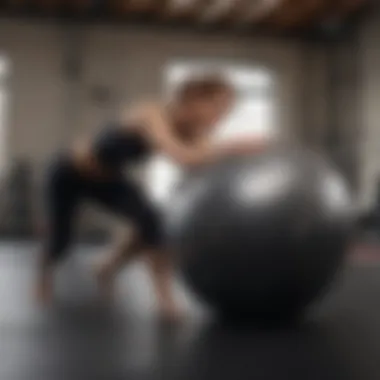Effective Core Workouts: Strengthen and Tone Your Abs and Back


Time Management Techniques
Task scheduling strategies are essential in allocating dedicated time slots for core workouts amidst busy schedules. By creating a weekly workout calendar and setting specific time blocks for different exercises, individuals can ensure regular engagement with core strengthening activities.
To prevent procrastination when it comes to core workouts, implementing small yet impactful habits can make a significant difference. Setting reminders, laying out workout clothes in advance, and committing to a consistent workout time can help individuals stay on track with their fitness goals.
Introduction to Core Workouts
Core workouts play a crucial role in enhancing overall strength and stability while targeting key muscle groups including the abdominal area, obliques, and lower back. A strong core is foundational to many physical activities and can help improve posture, prevent injuries, and support everyday movements. By focusing on core workouts, individuals can elevate their fitness levels and achieve a toned physique. This section will delve into the importance of core workouts, highlighting their benefits and key elements to guide readers towards optimal core strength and conditioning.
Importance of a Strong Core
The Core Muscles:
The core muscles encompass a network of muscles such as the rectus abdominis, obliques, and erector spinae, which are vital for maintaining proper posture and spinal alignment. These muscles provide stability and support to the spine, pelvis, and surrounding structures, contributing to overall strength and balance. Engaging the core muscles activates a strong foundation for various movements and exercises, making them essential for functional fitness and athletic performance. Understanding the role of the core muscles is fundamental to executing proper form and maximizing workout efficiency.
Benefits of Core Strength:
Core strength goes beyond achieving washboard abs; it enhances functional fitness, reduces the risk of injuries, and improves athletic performance. By developing a strong core, individuals can experience improved balance, agility, and coordination during workouts and daily activities. A stable core also alleviates lower back pain and enhances posture, promoting overall spinal health. Investing in core strength brings a range of benefits that extend beyond physical appearance, showcasing the significance of a robust core in achieving overall fitness goals.
Key Elements of Core Workouts


-#### Stability: Stability is a key component of core workouts as it focuses on maintaining control and balance during exercises. By strengthening stabilizing muscles, individuals can enhance their ability to perform movements with precision and control, reducing the risk of injury. Stability exercises challenge the core muscles to work cohesively, fostering improved coordination and alignment throughout the body. Integrating stability training into core workouts cultivates a solid foundation for progression and increased workout intensity.
-#### Flexibility: Flexibility plays a vital role in core workouts by ensuring a full range of motion in the muscles and joints. Incorporating flexibility exercises into core routines enhances muscle elasticity, reduces muscle stiffness, and improves overall mobility. Flexibility training aids in preventing muscle imbalances, enhancing muscle recruitment patterns, and reducing the likelihood of overuse injuries. By prioritizing flexibility within core workouts, individuals can optimize muscle function and movement efficiency, contributing to overall workout performance.
-#### Balance: Balance is a fundamental aspect of core workouts that promotes stability and coordination in various body positions. Enhancing balance through targeted exercises improves proprioception, which is essential for spatial awareness and body control. Balance training challenges the core muscles to stabilize the body in different planes of movement, enhancing neuromuscular efficiency and postural alignment. By incorporating balance drills into core routines, individuals can enhance their athletic performance, reduce the risk of falls, and elevate overall functional fitness levels.
Traditional Core Exercises
Traditional core exercises play a pivotal role in any comprehensive fitness regimen. These exercises target the core muscles, including the abdominal muscles, obliques, and lower back, which are crucial for overall stability and strength. By incorporating traditional core exercises into your workout routine, you can enhance your core strength, improve your posture, and reduce the risk of injuries during physical activities. These exercises form the foundation of core workouts and lay the groundwork for more advanced techniques and movements.
Crunches and Sit-Ups
Basic Crunches
Basic crunches are a fundamental core exercise that targets the rectus abdominis muscle, commonly referred to as the
Innovative Core Workouts
In the realm of core workouts, innovative exercises play a pivotal role in challenging the core muscles from different angles and intensities, thereby enhancing overall strength, stability, and toning. These workouts introduce unique variations that target the abdominal muscles, obliques, and lower back in unconventional yet effective ways. By incorporating innovative core exercises into your fitness routine, you can break through plateaus, prevent boredom, and achieve holistic core development. The integration of novel movements keeps the muscles engaged and promotes functional strength that translates into everyday activities. Emphasizing innovation in core workouts brings a fresh perspective to traditional routines, offering a dynamic approach to core training.
Ball Exercises


Stability Ball Rollouts
Stability Ball Rollouts are a dynamic core exercise that engages multiple muscle groups simultaneously, particularly targeting the deep stabilizing muscles of the core. By utilizing a stability ball, this exercise challenges balance, coordination, and core strength. The key characteristic of Stability Ball Rollouts lies in the elongation of the abdominal muscles throughout the movement, promoting full-range contraction and extension. This exercise is a popular choice in core workouts due to its scalability, as beginners can perform partial rollouts while advanced individuals can execute the full movement. The unique feature of Stability Ball Rollouts is the integration of instability, requiring constant engagement of the core to prevent any deviation from proper form. While this exercise enhances core strength and stability, individuals should pay attention to proper form to avoid strain on the lower back.
Leg Raises with Ball Squeeze
Leg Raises with Ball Squeeze is an effective exercise for targeting the lower abdominal muscles and hip flexors. By incorporating a stability ball between the feet and squeezing it throughout the movement, this exercise intensifies the engagement of the core muscles. The key characteristic of Leg Raises with Ball Squeeze is the added resistance provided by the ball, challenging the muscles to work against external pressure. This exercise is a beneficial choice for core workouts as it isolates the lower abdominal region, addressing common weak points in core development. The unique feature of Leg Raises with Ball Squeeze is the emphasis on control and precision, promoting mind-muscle connection for optimal results. While this exercise strengthens the core and enhances muscle coordination, individuals should avoid overarching the lower back to prevent strain.
Plank Roll-Ins
Plank Roll-Ins are a dynamic core exercise that combines aspects of the traditional plank with additional movement to target the obliques and lower abdominals. By rolling the knees towards the chest while maintaining a plank position, this exercise engages deep core muscles and challenges stability. The key characteristic of Plank Roll-Ins is the integration of both static and dynamic elements, requiring core muscles to stabilize the body while performing a controlled movement. This exercise is a popular choice for core workouts due to its effectiveness in sculpting the waistline and enhancing overall core strength. The unique feature of Plank Roll-Ins is the emphasis on core control and coordination, promoting a balanced development of the abdominal muscles. While this exercise improves core stability and muscle endurance, individuals should focus on maintaining proper alignment to maximize benefits and minimize strain.
Functional Core Workouts
Functional Core Workouts play a crucial role in this article, focusing on enhancing core strength through specific elements that target multiple muscle groups simultaneously. These workouts offer benefits beyond isolated exercises by improving overall coordination, functional movement patterns, and muscular endurance. When engaging in Functional Core Workouts, individuals should consider the complexity of movements to challenge the core effectively while emphasizing proper form and alignment to prevent injuries and maximize results.
Compound Movements
-#### Deadlifts: Deadlifts, a fundamental compound movement, contribute significantly to overall core strength by engaging not only the lower back and glutes but also the core muscles to stabilize the spine during heavy lifts. The key characteristic of Deadlifts lies in their ability to mimic real-life movements like picking up objects from the ground, making them a practical choice for functional fitness. Despite their effectiveness, Deadlifts require proper technique and form to avoid injury and maximize muscle engagement.
-#### Squats: Squats, another essential compound movement, are vital for developing lower body strength while also engaging the core for stability and balance. The key characteristic of Squats is their versatility in targeting multiple muscle groups simultaneously, making them an efficient choice for full-body workouts. Proper Squat form is essential to prevent knee or back strain and optimize muscle activation throughout the movement.


-#### Overhead Press: The Overhead Press is a compound movement focused on shoulder and upper body strength, requiring core stability to support the weight overhead. The key characteristic of the Overhead Press is its ability to strengthen the shoulders, triceps, and core muscles in one fluid motion, promoting functional strength. Individuals performing the Overhead Press should pay attention to maintaining core engagement to control the weight and prevent overarching the lower back.
Kettlebell Exercises
-#### Kettlebell Swings: Kettlebell Swings are dynamic exercises that target the posterior chain, including the glutes, hamstrings, and core muscles, providing a full-body workout. The key characteristic of Kettlebell Swings is their explosive nature, enhancing power and cardiovascular fitness while improving core stability. Proper hip hinge and core activation are crucial for executing Kettlebell Swings effectively and preventing strain.
-#### Turkish Get-Ups: Turkish Get-Ups are intricate kettlebell exercises that challenge core strength, stability, and coordination through a series of deliberate movements from lying to standing positions. The key characteristic of Turkish Get-Ups is their compound nature, engaging multiple muscle groups simultaneously to improve functional fitness. Attention to proper form and controlled movements is essential to reap the full benefits of Turkish Get-Ups.
-#### Windmills: Windmills are unilateral kettlebell exercises that focus on core stabilization, shoulder mobility, and hip flexibility, offering a unique challenge for core strength. The key characteristic of Windmills is their emphasis on rotational movement patterns that target obliques and deep core muscles. Individuals should execute Windmills with controlled precision and focus on maintaining alignment to enhance core engagement and prevent strain.
Core Workouts for All Fitness Levels
In this section, we delve into the significance of Core Workouts for All Fitness Levels within the broader spectrum of effective core exercises for strengthening and toning. Catering to individuals of various fitness levels, these routines play a pivotal role in enhancing core strength, stability, and overall fitness. Whether you are a beginner taking your initial steps towards a stronger core or an advanced fitness enthusiast seeking new challenges, core workouts tailored to different fitness levels provide the foundation for a well-rounded fitness regimen.
Beginner Core Routines
Modified Plank
Exploring the Modified Plank, we encounter a foundational exercise that serves as an excellent entry point into core strengthening. This variation of the traditional plank exercise offers a milder yet effective way to engage the core muscles. The Modified Plank is characterized by its simplicity and accessibility, making it a popular choice for individuals embarking on their fitness journey. Its unique feature lies in the reduced intensity compared to standard planks, allowing beginners to build core strength gradually without risking overexertion. While the Modified Plank may lack the intensity of advanced core exercises, its advantage lies in providing a safe and effective starting point for individuals looking to develop core stability.
Leg Raises
Moving on to Leg Raises, we encounter a dynamic exercise targeting the lower abdominal region. Known for its effectiveness in engaging the lower core muscles, Leg Raises offer a challenging yet rewarding workout for individuals looking to tone and strengthen their abs. The key characteristic of Leg Raises is the emphasis on controlled movements, requiring core stability to lift and lower the legs effectively. While Leg Raises can be demanding, especially for beginners, their main advantage lies in sculpting the lower abs and improving overall core strength.
Bicycle Crunches
Lastly, we explore Bicycle Crunches, a dynamic exercise that targets multiple core muscles simultaneously. This exercise is characterized by its rotational movement, engaging not only the rectus abdominis but also the obliques. Popular for its ability to challenge the core from different angles, Bicycle Crunches stand out as a versatile choice for individuals seeking to enhance overall core strength and definition. The unique feature of Bicycle Crunches lies in their capacity to elevate heart rate, making them a beneficial choice for cardiovascular fitness in addition to core strength. While demanding, Bicycle Crunches offer a comprehensive workout for the core muscles, promoting both strength and endurance.



